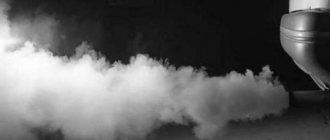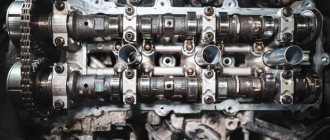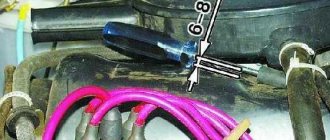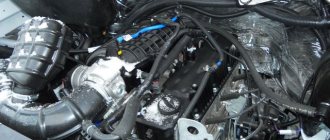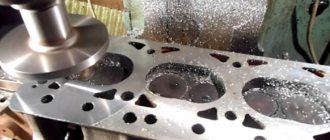Stable operation of the engine is facilitated by a properly functioning cooling system that maintains the engine temperature within the operating range. Any malfunction of the cooling system parts can cause the car engine to overheat, adversely affecting its performance and even causing it to fail - in especially severe cases.
The reasons for engine overheating can be very different. Some of them are quite trivial, others are much more serious. The problem of increased drive unit temperatures cannot be underestimated. The cause of the engine overheating must be found as soon as possible, and then everything must be done to restore it to normal.
In cases of overheating, there are two possible outcomes: the engine must be restored, or due to misalignment of the head and cylinder block, the engine assembly will have to be replaced.
Possible causes of engine overheating
When designing the engine structure, engineers take into account the fact that the unit will operate for a long time in a strictly defined temperature range. In simple words, it takes into account the fact that after starting the engine gains temperature to the operating zone, after which this range is maintained throughout the entire operation of the engine.
As a rule, in modern power units the temperature range that is considered operating varies from 85 to 110 degrees. This means that the task of the cooling system is to prevent the temperature from exceeding a given threshold.
The importance of maintaining operating temperature is explained by the fact that this contributes to a favorable engine operating mode, the ratio of operating gaps between parts, maintaining the required viscosity of the engine oil and preserving its properties.
Fuel consumption also depends on the engine temperature, since in injection engines the coolant temperature sensor is involved in mixture formation.
Coolant leak
If topping up the missing coolant does not solve the problem and the engine continues to overheat, this may indicate a leak.
An antifreeze leak leads to instant overheating, and the cooling system is filled with air, forming a plug. There are many reasons for a coolant leak:
- damage to the rubber pipe,
- radiator destruction,
- faulty water pump seal,
- breakdown of the cylinder head gasket,
- heat exchanger malfunction.
The situation is corrected by replacing faulty parts with new ones, and if it is impossible to replace the damaged part in time, you can use a sealant for the cooling system.
Car engine overheating due to radiator malfunctions
A defective radiator is most often responsible for loss of coolant. It should be remembered that this element of the car is located in such a way that it is constantly exposed to harmful external factors.
The most dangerous are water and salt, which can cause the radiator to leak, which usually occurs in the lower part. Fortunately, checking this fact does not require visiting a specialized center.
All you have to do is start the engine and make sure there are no stains under the front of the car. If there are any, this will indicate a hole in the radiator, which usually causes it to be replaced. If there is no stain, you need to check other components of the cooling system.
Radiator hose defects
The source of the leak can also be clearly visible radiator hoses. If they are cracked, the driver will have to replace them with new ones. It is necessary to check their condition, as well as the assembly on the connectors on which they may have been applied too loosely.
Cable clamps
The cables on the connectors are mounted using clamps. Over time, corrosion can occur so they don't hold the radiator hoses with enough strength. This may also lead to leakage.
Head connector
The plastic tip can also cause a coolant leak. Over-tightening will cause crack damage, which may lead to leakage. The damaged part should be replaced with a new one.
The engine overheats due to insufficient circulation
Often the culprit of poor circulation is contamination of the cooling jacket and radiator. This happens due to the use of low-quality fluid, which leaves sulfate deposits that block the path for coolant.
The source of the problem with increased engine temperature can also be a damaged coolant pump, which is responsible for circulating fluid in the cooling system. Pumps equipped with a plastic impeller are most susceptible to this problem.
If the water pump fails, the efficiency of the system is reduced: it may leak fluid, the pulley may jam due to the bearing, or rotate with play.
When purchasing a new non-original pump, you may notice that the impeller of the cheaper pump has a different shape, which means it will not provide working pressure to the system.
Signs of overheating. What to do when they appear
To prevent damage to the engine, you should monitor the temperature using the sensor while driving. But this sensor may be broken, and other signs will indicate a problem:
- the appearance of a characteristic odor of very hot antifreeze (initial stage of overheating). Due to strong heating, part of it goes into a gaseous state, which causes pressure in the system to increase. When a certain point is reached, some of the steam will be released through the valve in the lid, which is why the smell of coolant appears;
- clouds of steam coming out from under the hood (medium). When the temperature rises too much, a lot of coolant becomes steam, and the pressure in the system increases sharply, the valve no longer has time to install it and steam begins to break through the lid, and one of the pipes may also break off.
If even the slightest signs appear, you should immediately pull off the road, turn off the engine and open the hood. Next, you should wait for the engine to cool down.
Under no circumstances should you touch the expansion tank cap and pipelines immediately after stopping. Because due to the steam, there is high pressure inside the system, and the slightest impact on the components can lead to a breakthrough of hot steam, which can result in severe burns.
Inspection of the engine should be carried out only after the sounds of boiling (gurgling) liquid disappear. First you should check the level in the tank to assess coolant loss. Next, you should check the fastening of all pipelines of the system.
On the road, it is almost impossible to determine what caused the engine to boil. But you can wait until the engine has completely cooled down, replenish the antifreeze level with water and continue driving, constantly monitoring the temperature. If it is exceeded, we stop again, wait for it to cool down and continue driving. This way you can get to the right place for repairs and coolant replacement.
Other problems that cause the engine to overheat
An antifreeze leak is the most common, but only one cause of engine overheating. Other items may be responsible, including the fan, thermostat, temperature sensor, coolant pump, or head gasket.
temperature sensor
Increased engine temperature may be indicated by a faulty temperature sensor, which should be checked by connecting the car to a computer or replacing it with a new part. It is worth emphasizing that the problem can be not only the sensor itself, but also the power cable.
Thermostat
The thermostat is the element responsible for maintaining the correct engine temperature. When it overheats, it's worth taking a closer look. It is not difficult. You just need to put your hand on the hose leading to the radiator.
If it is warm and stiff, then the thermostat is working properly. If the thermostat fails, you can expect two scenarios: long warm-up and overheating.
A cold pipe is a sign of jamming in the closed position, when the coolant works in a small circuit, bypassing the radiator, and accordingly, overheating is inevitable.
In this situation, the driver can only replace the thermostat and then ventilate the entire system.
Fan
It is also worth focusing on ventilation if the engine overheats during slow city driving. Most likely, the culprit is the belt that could have fallen off it. Additionally, the power cord may also be unplugged.
Cylinder head gasket
A damaged head gasket can also cause the engine to overheat. Then increased engine temperature is just one of the signs of such a failure. Other symptoms that indicate a gasket problem include white exhaust fumes and bubbles appearing in the expansion tank.
Design, principle of operation, diagnostics of temperature sensors
Engine temperature sensors.
Engine coolant temperature sensor Intake air temperature sensor. There are different types of engine control systems, the design of which can vary significantly. But any engine control system must use a coolant temperature sensor. Most systems use an air temperature sensor in the engine intake tract. External view of the engine temperature sensor - coolant (left) and the air temperature sensor in the intake tract (right)
Depending on the coolant temperature, the engine control unit adjusts the composition of the air-fuel mixture, the engine idle speed, and the ignition timing. The influence of the coolant temperature sensor readings on the operation of the engine management system is very great. For example, if, due to a malfunction, the engine coolant temperature calculated by the engine control unit does not match the actual engine coolant temperature by a significant amount, the engine may stall/not start. Most air temperature sensors in the intake tract are similar in design and operating principle to the coolant temperature sensor. Depending on the air temperature in the intake tract, the engine control unit slightly adjusts the composition of the air-fuel mixture. The influence of the intake air temperature sensor readings on the operation of the engine management system is especially noticeable in systems where an air flow sensor is not used.
What to do if the engine overheats
If the engine temperature indicator is approaching or is already in the red field, you must stop the vehicle in a safe place and turn off the engine. Then check the cooling system. It may turn out that overheating of the car engine is caused by a lack of refrigerant, which in this case needs to be replenished as soon as possible.
Do not forget that it is forbidden to top up when the engine is hot - you need to wait until the temperature of the internal combustion engine and the coolant itself drops. Otherwise, the driver will be subject to severe burns when opening the expansion tank.
You should also remember that you cannot add cold antifreeze to hot antifreeze - this may adversely affect its properties.
Operating principle of engine temperature sensors
Thermistors with a negative temperature coefficient are used as coolant temperature sensors and most air temperature sensors in the engine intake tract - as the temperature of the engine temperature sensor increases, its resistance decreases. The coolant temperature sensor is installed in the engine coolant flow. At low coolant temperatures, the sensor resistance is high (3.52 kQ at +20 °C); at high temperatures, the sensor resistance is low (240 Q at +90 °C). From the engine control unit, through a resistor with constant electrical resistance located inside the engine control unit, a support is supplied to the engine temperature sensor. voltage is 5 V. The second terminal of the sensor is connected to ground.
Circuit diagram for connecting an engine temperature sensor, the sensing element of which is a thermistor. ECU Engine control unit.
- Connection point for the alligator clip of an oscilloscope probe.
- Connection point for an oscilloscope probe to obtain a waveform of the sensor's output voltage.
- Temperature sensor.
- Ignition switch.
- Accumulator battery.
The engine temperature sensor shunts the support. voltage, as a result of which the voltage value at the sensor turns out to be less than the references. As the coolant temperature increases (for example, when the engine warms up), the resistance of the sensor decreases and, accordingly, the voltage on the sensor decreases. Based on the value of this voltage, the engine control unit calculates the current value of the engine coolant temperature.
